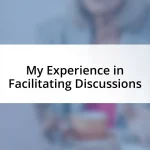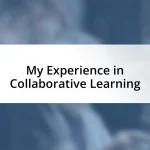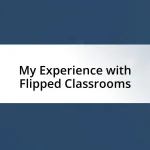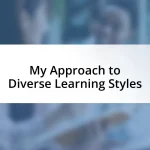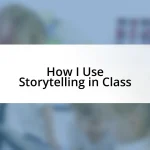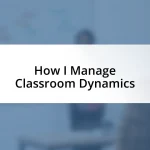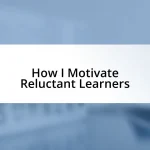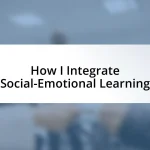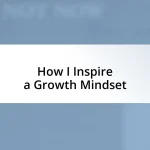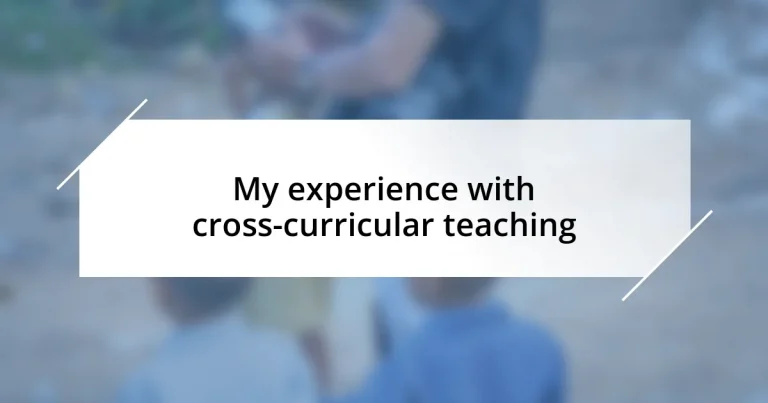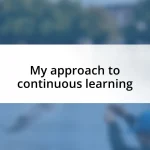Key takeaways:
- Cross-curricular teaching enhances student engagement by connecting subjects and fostering real-world applications, such as blending literature with science to create a tangible understanding of ecological issues.
- Effective integration strategies include collaborative planning with colleagues, making real-world connections, allowing student choice, and encouraging reflective activities.
- Challenges such as aligning different curriculum standards, time constraints, and student resistance can occur, but fostering an open mindset helps overcome these barriers.
- Successful implementations, like combining art and math in geometric sculptures or integrating literature with social studies through historical fiction, demonstrate the effectiveness of cross-curricular approaches in deepening comprehension and student pride.
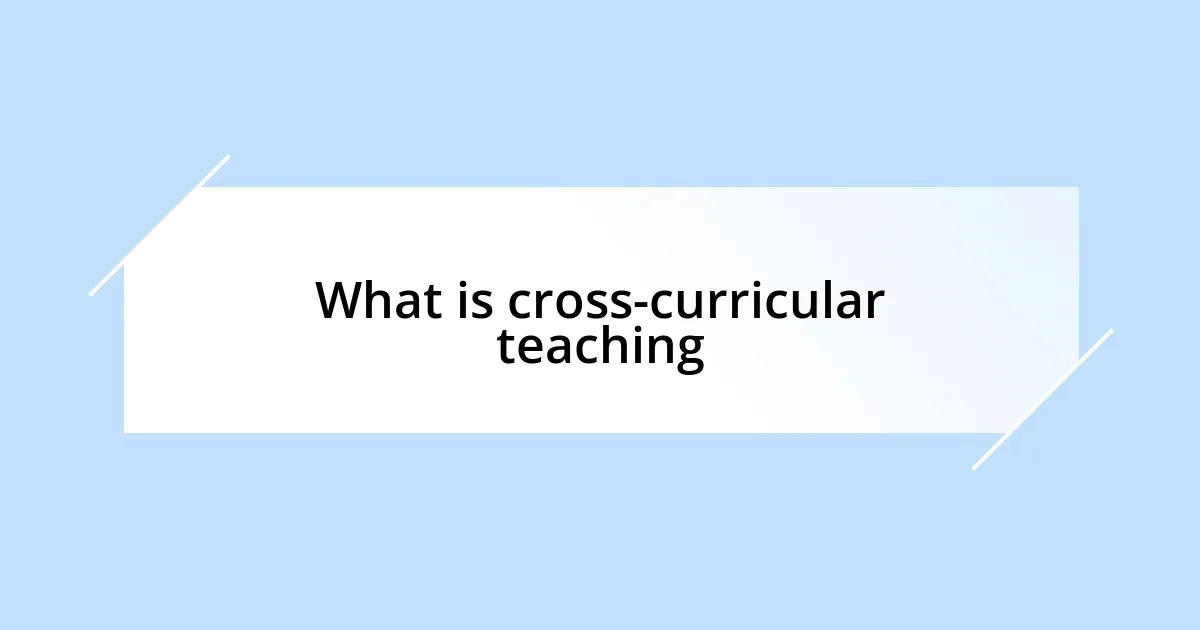
What is cross-curricular teaching
Cross-curricular teaching is an educational approach that integrates multiple subjects into a cohesive learning experience. By connecting topics, teachers can create richer, more engaging lessons that allow students to see the real-world applications of what they’re learning. For instance, I once combined a science unit on ecosystems with art by having my students create dioramas. This didn’t just deepen their understanding; it ignited their creativity.
Think about it: when students learn about history, math, or literature, why not show them how these subjects intermingle? I remember a project where we analyzed historical events in math class through timelines and statistics. It made the data come alive! Suddenly, those numbers weren’t just figures; they represented real people and stories. I felt a sense of satisfaction seeing students connect the dots.
As an educator, I’ve found that cross-curricular teaching not only enriches knowledge but also fosters critical thinking. When students apply knowledge in diverse contexts, they develop a more comprehensive skill set. Don’t you think this approach prepares them better for the complexities of the world? Through my experiences, I’ve witnessed students growing into lifelong learners who are excited about exploration and discovery.
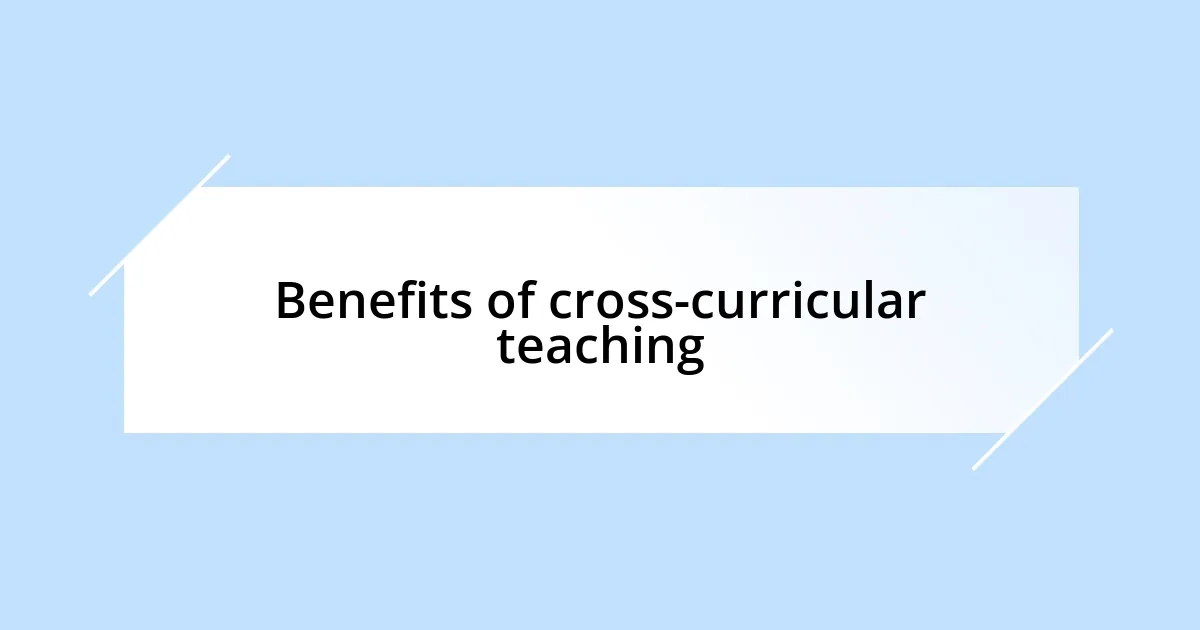
Benefits of cross-curricular teaching
Cross-curricular teaching opens doors to deeper learning experiences. When I implemented a project that combined literature with science, my students had to read an environmental novel, discuss its themes, and then create a scientific report on the specific ecological issues highlighted in the story. The excitement in the classroom was palpable; they weren’t just reading or writing for the sake of grades, but genuinely learning about the world around them. It’s a powerful reminder of how interlinking subjects can heighten engagement and retention.
I’ve also seen firsthand how this approach nurtures creativity. One memorable lesson involved matching historical figures with modern-day social issues. Students paired up to create presentations that illustrated these connections. They tapped into their analytical skills while expressing themselves artistically, which was a joy to observe. It’s rewarding to see students thrive when they realize they can tackle not just one subject, but weave together many strands of knowledge.
Furthermore, cross-curricular teaching equips students with essential life skills. In a unit blending math and physical education, students tracked their fitness progress, analyzing data to set personal goals. This was not only educational but also empowering, as they learned accountability and perseverance in a practical way. When I reflect on these moments, I realize that my role goes beyond teaching; it involves shaping well-rounded individuals who are prepared to face diverse challenges.
| Benefit | Personal Experience |
|---|---|
| Enhanced Engagement | Students eagerly dove into literature and science projects, showing genuine excitement. |
| Creativity Development | Pairing historical figures with modern issues led to unforgettable student presentations. |
| Life Skills Acquisition | Tracking fitness goals through math taught accountability and perseverance. |

Strategies for effective integration
Integrating subjects effectively requires thoughtful planning and collaboration. I remember a collaborative lesson where I joined forces with my colleague from the art department. We created a project that combined history and visual arts by having students reimagine historical events through various art forms. Watching them transform facts into something uniquely personal made me realize how powerful integration can be. It not only deepened their understanding but also allowed them to express their interpretations in a way that resonated with them emotionally.
Here are some strategies I’ve found effective for ensuring seamless integration:
- Collaborative Planning: Work together with colleagues from different subjects to create thematic units.
- Real-World Connections: Incorporate current events and real-life applications to make learning more relevant.
- Flexibility: Be open to adjusting your lessons based on students’ interests and questions for a more engaging experience.
- Student Choice: Allow students to choose how they demonstrate understanding, whether through presentations, art, or research projects.
- Reflective Activities: Encourage students to reflect on what they’ve learned across disciplines, helping them synthesize knowledge.
These strategies have significantly enhanced not just my teaching, but also my students’ learning experiences. It feels gratifying to see them making connections and expressing themselves in ways that surprise even themselves!
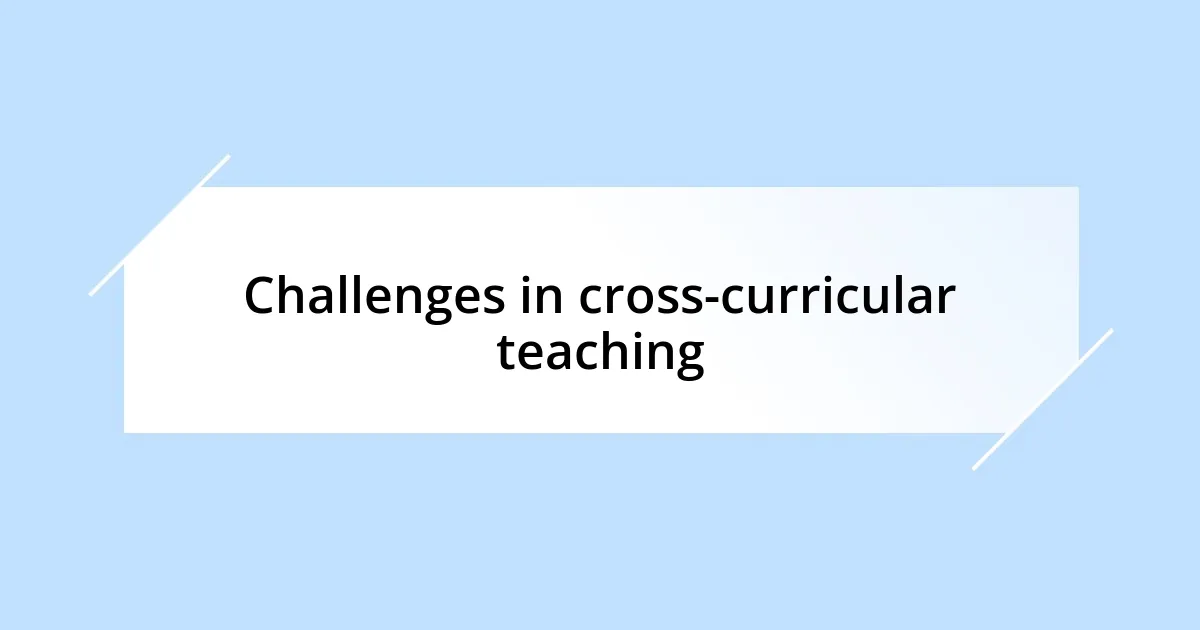
Challenges in cross-curricular teaching
Cross-curricular teaching can be incredibly rewarding, but it isn’t without its hurdles. One significant challenge I faced was aligning different curriculum standards. I remember attempting to merge a social studies unit with science concepts about natural resources. While the idea was exciting, I found myself bogged down in ensuring every standard was met across both subjects. It felt overwhelming at times—how could I prioritize depth of understanding without missing crucial benchmarks?
Another issue I encountered was time constraints. When I first tried integrating math with literature, I planned for deep discussions and explorations. However, I quickly learned that fitting both subjects into the same timeframe was tricky. How often do we find ourselves cutting short engaging conversations just to stay on schedule? It’s frustrating, especially when I could see my students thriving in those moments. Balancing the logistics of cross-curricular lessons while keeping engagement high felt like walking a tightrope.
Lastly, student resistance can pose a barrier. Initially, when I introduced a project that combined physical education with environmental science, some of my students met the idea with skepticism. They preferred the familiar routines of isolated subjects. Even though I knew the potential for meaningful connections existed, coaxing them out of their comfort zones was tough. Reflecting on those experiences taught me the importance of nurturing an open mindset and fostering a classroom environment where exploration feels safe and encouraged.
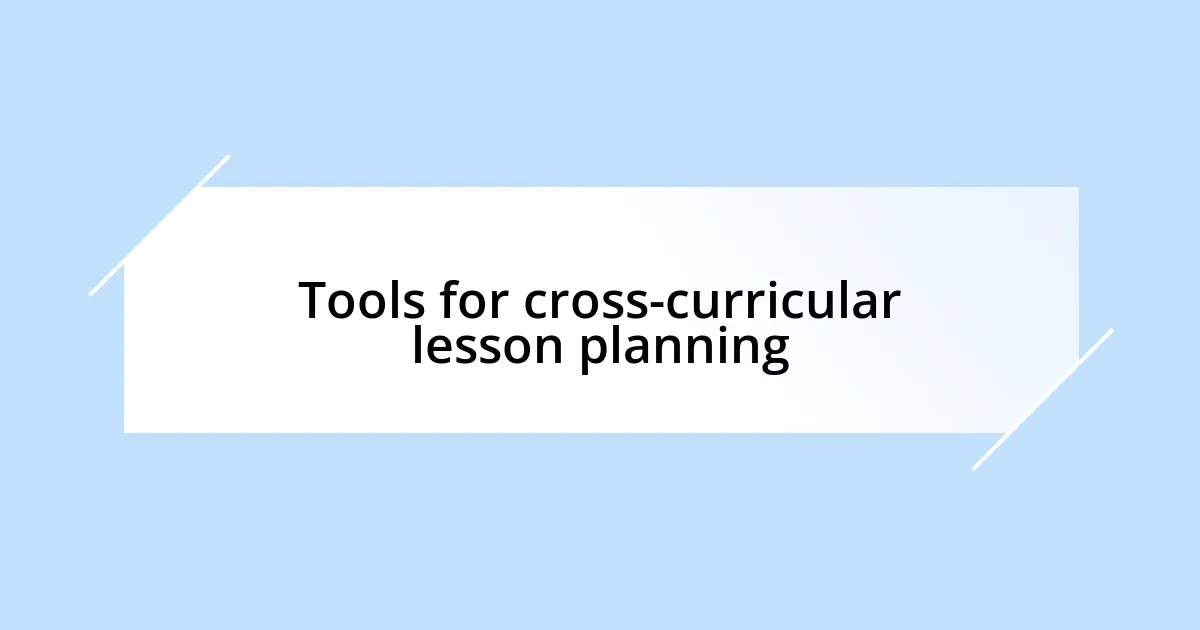
Tools for cross-curricular lesson planning
When planning cross-curricular lessons, finding the right tools is essential. I’ve turned to digital planning platforms like Google Classroom, which facilitates collaboration with fellow educators. It’s amazing how sharing resources and ideas in real-time can spark creativity. Have you ever experienced that “aha” moment when a colleague’s suggestion transforms your lesson plan? It’s a game-changer.
Additionally, incorporating graphic organizers has been incredibly helpful in structuring cross-curricular lessons. Visual aids like Venn diagrams or concept maps allow me to lay out connections between different subjects clearly. I recall guiding my students through a visual comparison of mathematical principles in art and science. Watching their eyes light up as they identified patterns across disciplines was truly rewarding.
And let’s not forget about community resources! I once partnered with a local museum to create a project-based learning experience that combined history, art, and environmental science. The excitement in the classroom as we planned the field trip—imagining how the tangible world would enhance our learning—was palpable. Have you ever brought in external resources that made a lesson come alive? It’s these moments of connection that solidify cross-curricular teaching in the minds of both the teacher and the students.
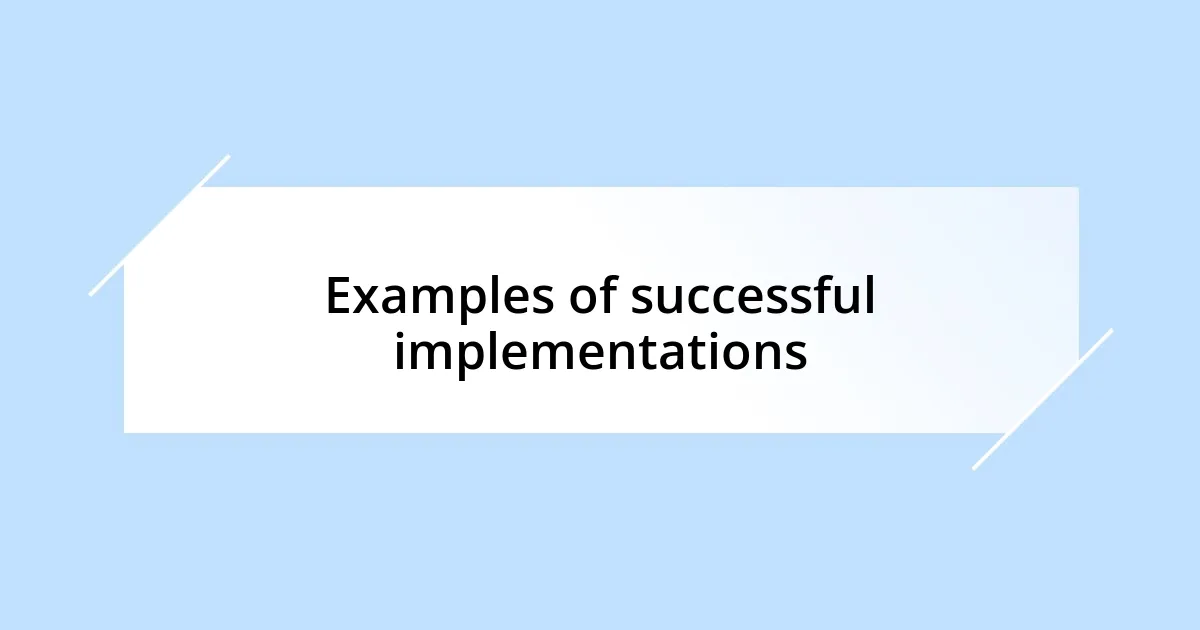
Examples of successful implementations
When I implemented a cross-curricular project combining art and mathematics, my students created geometric sculptures. The beauty of seeing them transform abstract math concepts into tangible art pieces was incredible. Watching their pride as they explained the calculations behind their designs truly reinforced their understanding. Have you ever noticed how hands-on projects can spark excitement and deepen comprehension?
Another memorable instance was when I integrated literature and social studies through a historical fiction reading project. Students dove into books set during significant historical events. I loved how they not only engaged with the narratives but also conducted research on the time periods, blending storytelling with factual exploration. It became apparent that literature could provide a profound context that history alone sometimes missed—don’t you think exploring text through a multifaceted lens enhances relatability?
Lastly, I recall a science and physical education unit focused on ecosystems and the human impact on our environment. We spent days in the local park, studying biodiversity while participating in running exercises that simulated animal behaviors. The laughter and teamwork from this outdoor learning experience was infectious. It reinforced for me that education doesn’t have to happen within four walls; have you ever felt that a different environment can invigorate learning in unexpected ways?
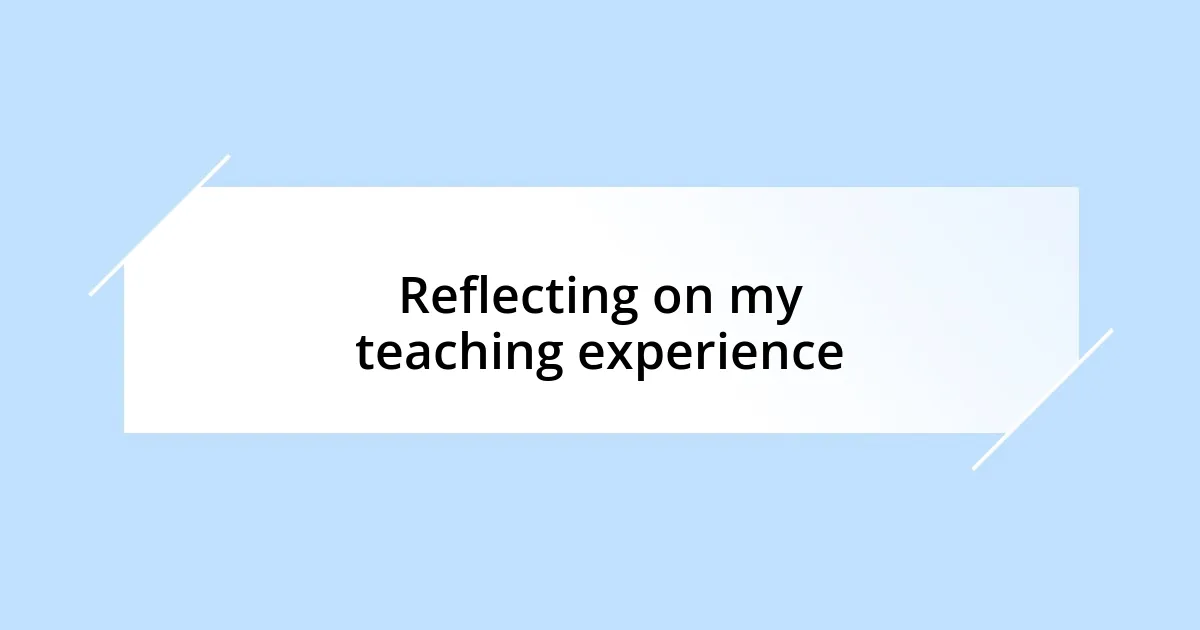
Reflecting on my teaching experience
Reflecting on my teaching experience has allowed me to see the profound impact cross-curricular approaches can have on student engagement. I still vividly remember a time when I connected geography and creative writing. After sharing stories about different cultures, my students eagerly crafted their own travel narratives, embodying the excitement of exploration. Isn’t it inspiring to witness young minds igniting their imaginations through a blend of facts and creativity?
One particular moment stands out: when I merged science with literature during a unit on environmental issues. I introduced my students to eco-themed novels, prompting them to create their own essays on sustainability. The conversations we had were electric, filled with passion and concern for our planet. Reflecting on this, I often wonder how literature can serve as a catalyst for social change. Have you discovered similar connections that drive meaningful discussions in your classroom?
Finally, I’ve noticed that my professional growth is intertwined with these cross-curricular experiences. Embracing collaboration with other teachers has pushed me to refine my methods and broaden my perspective. I find that these partnerships not only enhance lesson delivery but also foster a community of learning among educators. Have you ever felt that collective learning is as transformative as the lessons we deliver to our students?
